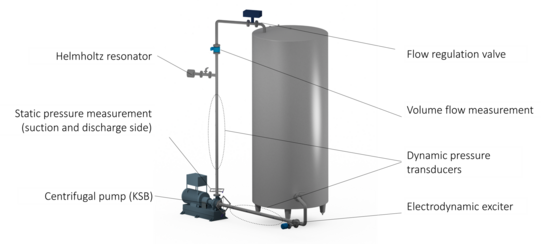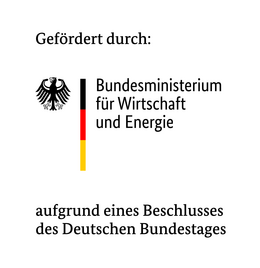Hydro acoustic test rig
Investigation into acoustic characteristics of centrifugals pumps and hydraulic components
The Hydro acoustic test rig at the Chair of Fluidics is designed for the investigation of acoustic properties of hydraulic machinery and components. In the current configuration, the passive (transmission properties) and active (excitation) characteristics of a centrifugal pump can be determined experimentally. Currently the test rig can be operated under atmospheric conditions only. An extension with a pressure-resistant water tank and the resulting possibility of over- and underpressurisation is in planning stage.
The particular components are described in the following:
drive
The test rig in the current configuration is driven by a variable speed KSB centrifugal pump.The pump's operating point is adjusted by means of a regulation valve.
process variables
In the suction piping the water temperature is measured by means of a thermocouple in order to take into account its influence onto the speed of sound. Right before and after the pump the mean static pressure is measured by means of capacitive pressure transducers mounted in ring lines. In conjunction with an inductive volume flow meter mounted in the discharge piping, the total pressure before and after the pump and thus the pump's operating point (head over volume flow) can be determined.
assessment of duct acoustics
On both sides of the pump cascades of axially staggered dynamic piezoelectric pressure transducers a flush-mounted, which are used to evaluate the plane wave acoustic field in both pipes independently.
electrodynamic exciter
For the determination of the transmission properties of hydraulic machinery or components an external sound source is required. In the hydro acoustic test rig this source is realised by means of an electrodynamic exciter, which is mounted onto a flexible membrane, which transforms the exciter's lateral movement into acoustic waves in the hydraulic system. Amplitude and frequency (up to 500 Hz) are variable. The exciter can be mounted on the suction and discharge side.
Helmholtz resonator
For the measurement of acoustic transmission matrices (four pole matrices) a variation of the piping system's impedance (acoustic system response) is required. For this purpose a Helmholtz resonator is mounted onto the piping, which can be coupled to and decoupled from the hydraulic system by means of a ball valve. The Helmholtz resonator can also be mounted on the suction and discharge side.




